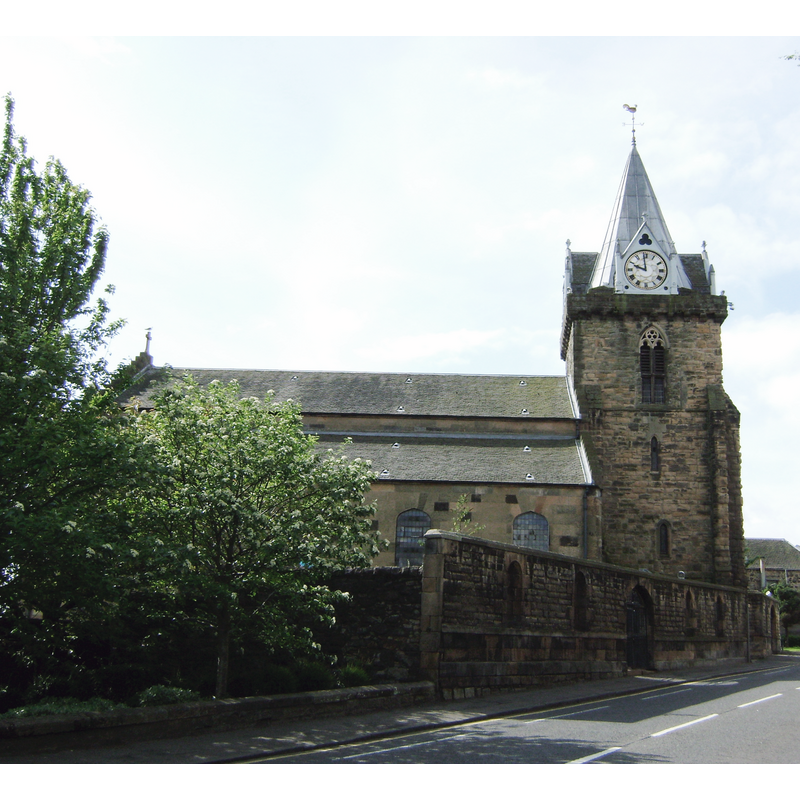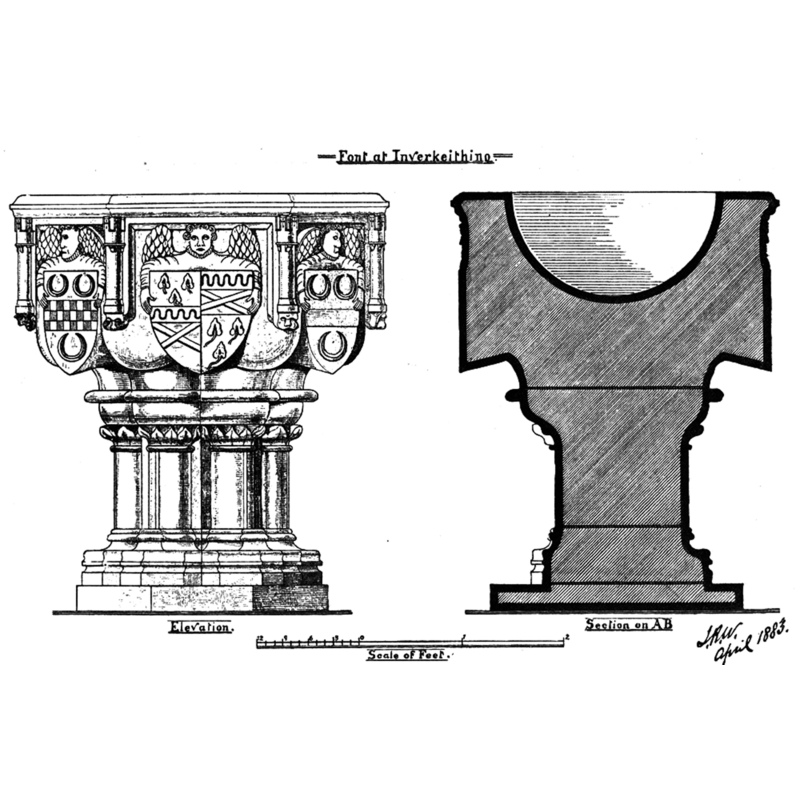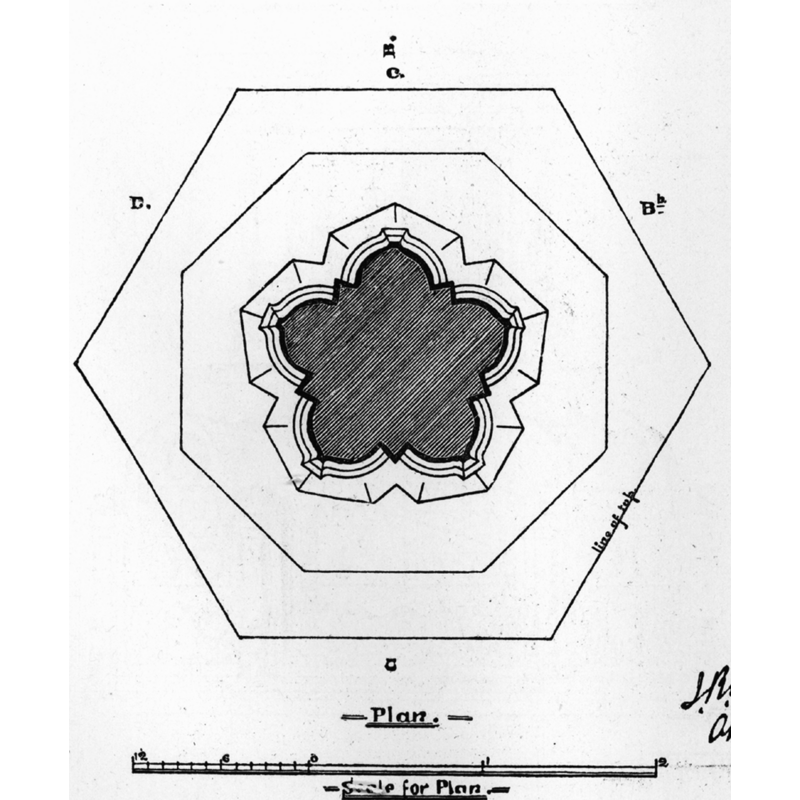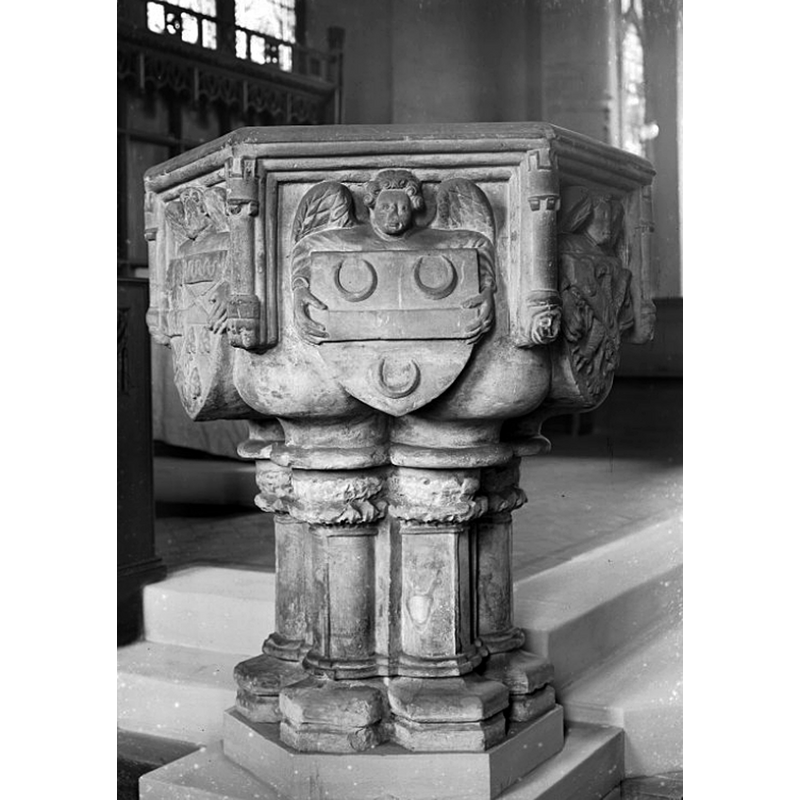Inverkeithing / Inbhir Chèitinn
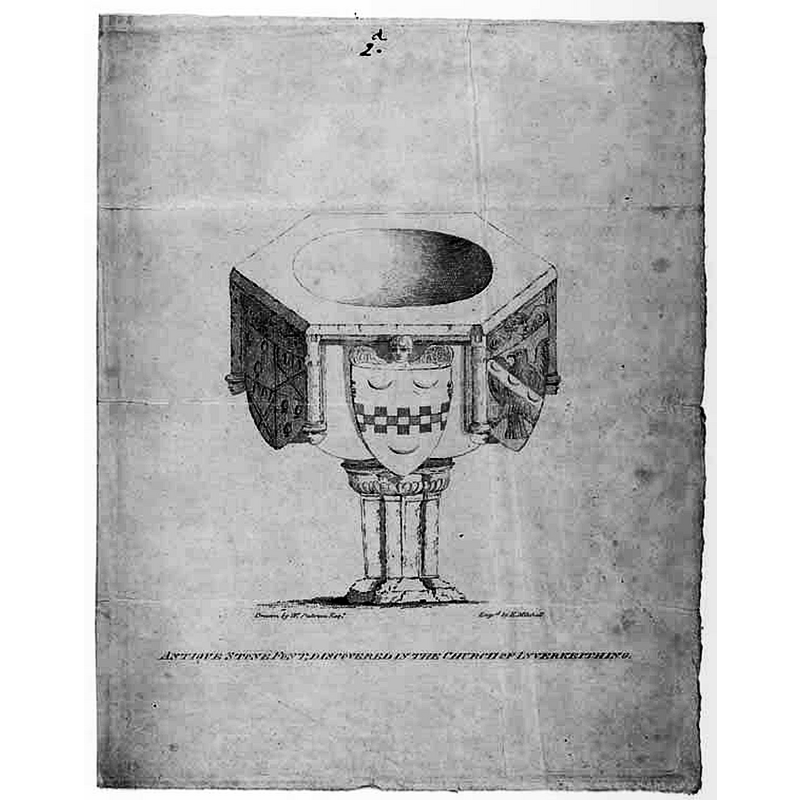
Image copyright © National Library of Scotland, 2012
CC-BY-SA-4.0
Results: 17 records
angel - holding shield - coat of arms - 8
Scene Description: each shield is held by an angel; visible only the upper part of the torso and the wings, as well as the arms [cf. Chalmers (1844) problem with identification of these arms]
Copyright Statement: Image copyright © [in the public domain]
Image Source: digital image of an illustration in MacGibbon & Ross (v. II: fig. 941)
Copyright Instructions: PD
coat of arms - Foulis of Colinton, and Bruce of Balcaskie
Scene Description: "Quarterly 1st and 4th, three bay leaves, for Foulis of Colinton; 2nd and 3rd, saltier and chief, wavy [...] Bruce of Balcaskie" (a/p identification in Walker and MacGibbon & Ross) [cf. Chalmers (1844) problem with identification of these arms]
Copyright Statement: Image copyright © [in the public domain]
Image Source: digital image of an illustration in Walker (1887: 433)
Copyright Instructions: PD
coat of arms - Lyon of Glamis
Scene Description: "Lyon rampant within a double tressure [...] Lyon of Glamis: (Glamis or Glammis)(a/p identification in Walker and MacGibbon & Ross) [cf. Chalmers (1844) problem with identification of these arms]
Copyright Statement: Image copyright © [in the public domain]
Image Source: digital image of an illustration in Walker (1887: 433)
Copyright Instructions: PD
coat of arms - Lyon of Glamis and Drummond
Scene Description: "Per pale, dexter side, a lion rampant within a double tressure [...] Lyon of Glamis. On the sinister side, bars wavy, for Drummond" (a/p identification in Walker and MacGibbon & Ross) [cf. Chalmers (1844) problem with identification of these arms]
Copyright Statement: Image copyright © [in the public domain]
Image Source: digital image of an illustration in Walker (1887: 433)
Copyright Instructions: PD
coat of arms - Melville of Glenbervie
Scene Description: "Fesse between three crescents [...] Melville of Glenbervie" ( (a/p identification in Walker and MacGibbon & Ross) [cf. Chalmers (1844) problem with identification of these arms]
Copyright Statement: Image copyright © [in the public domain]
Image Source: digital image of an illustration in Walker (1887: 433)
Copyright Instructions: PD
coat of arms - Ramsay of Dunoun
Scene Description: "An eagle displayed, surmounted by a bend with three crescents [...] Ramsay of Dunoun" ( (a/p identification in Walker and MacGibbon & Ross) [cf. Chalmers (1844) problem with identification of these arms]
Copyright Statement: Image copyright © [in the public domain]
Image Source: digital image of an illustration in Walker (1887: 433)
Copyright Instructions: PD
coat of arms - Stewart
Scene Description: "A fesse chequé between three crescents [...] Stewart" (a/p identification in Walker and MacGibbon & Ross) [cf. Chalmers (1844) problem with identification of these arms]
Copyright Statement: Image copyright © [in the public domain]
Image Source: digital image of an illustration in MacGibbon & Ross (v. II: fig. 940)
Copyright Instructions: PD
design element - architectural - buttress - 8
design element - architectural - column - clustered columns
design element - patterns - crenellated
human figure - head - 8
view of church exterior - north view
Scene Description: Source caption: "Inverkeithing (St Peter's) Parish Church, Church Street, Inverkeithing, Fife, Scotland"
Copyright Statement: Image copyright © Klinburn, 2009
Image Source: edited detail of a digital photograph 21 May 2009 by Klinburn [https://commons.wikimedia.org/wiki/File:(looking_towards)_Inverkeithing_Church,_Inverkeithing.jpg] [accessed 22 February 2023]
Copyright Instructions: CC-BY-SA-3.0
view of church exterior - southwest view
Scene Description: Source caption: "St Peter's Church, Inverkeithing"
Copyright Statement: Image copyright © Ian S, 2014
Image Source: edited detail of a digital photograph 23 October 2014 by Ian S [https://www.geograph.org.uk/photo/4239550] [accessed 22 February 2023]
Copyright Instructions: CC-BY-SA-2.5
view of font
Scene Description: Source caption: "This engraving is by E. Mitchell from a drawing by W. Paterson, and is one of two such engravings in the Hutton Collection. Mounted on a decorative pedestal, the font includes stone carvings of several coats of arms held in place by angels. There is no date attached. In this instance, the church being referred to is probably St Peter's Kirk, which dates from the early-twelfth century and is located on Church Street in the centre of Inverkeithing. The armorial font, seen here, and the church tower are all that remain of the original pre-Reformation parish church. According to Groome (1894), the sculpted font was one of the finest in Scotland. He also noted that it was 'disinterred from the rubbish in 1806 in making foundations for repairs on the church'."
Copyright Statement: Image copyright © National Library of Scotland, 2012
Image Source: digital image of an engraving by E. Mitchell from a [ca. 1781-1820] drawing by W. Paterson, Adv.MS.30.5.23 in the Hutton Collection of the National Library of Scotland [ https://digital.nls.uk/74635624] [accessed 22 February 2023]
Copyright Instructions: CC-BY-SA-4.0
view of font - elevation and section
view of font - section
INFORMATION
FontID: 00388IVE
Object Type: Baptismal Font1
Church/Chapel: Inverkeithing Church
Church Patron Saints: St. Peter
Church Location: Church St, Inverkething, Fife, Scotland, United Kingdom
Country Name: Scotland
Location: Fife
Directions to Site: Located off the B981, 6 km SE of Dunfermline, E of the M90 and the A8000, on the N bank of the Firth of Forth
Ecclesiastic Region: Diocese of St. Andrews
Font Location in Church: [cf. FontNotes]
Date: ca. 1398?
Century and Period: 14th century (late?), Decorated
Workshop/Group/Artisan: heraldic font / hexagonal font
Church Notes: church here claimed since 5thC; replaced by Norman church; Walker (1887: 437) informs that the "original parish church was dedicated to St Peter, and was bequeathed in 1139 to Dunfermline Abbey by Waldeve, son of Gospatric."
Font Notes:
Click to view
http://www.scottishchurches.org.uk/sites/site/id/2430/name/Inverkeithing+St.+Peter%27s+Pa+Church+Inverkeithing+Fife
Illustrated in an engraving by E. Mitchell from a [ca. 1781-1820] drawing by W. Paterson, Adv.MS.30.5.23 in the Hutton Collection of the National Library of Scotland [ https://digital.nls.uk/74635624] [accessed 22 February 2023]. Chalmers (1844) reports: "In the porch of the present church is placed a font, made of sandstone, which was found when the late church was repaired in 1806. 'Its form is hexagonal, the extreme breadth being a little more than three feet, and, with its pedestal, it is about four feet high. The bowl of it is a sort of hemisphere, two feet broad, and one deep, with a hole about an inch diameter, pierced through the bottom. It had been carefully buried, and surrounded with a straw, the remains of it were still beside it, and it contained within the bowl of it a quantity of human bones, probably relics, and an ink-glass. The six angles of it are wrought into a kind of ornamental pillar, and of wveryone of the six faces there is a bust of an angel with expanded wings, having on its breast, and supported by its hands, a shield of a triangular form with curved outlines. These shields contain ancient armorial bearings. By persons skilled in heraldry, these are said to be the arms of Scotland; those of David Bruce, and Margaret Logie, his queen, or of Robert III, and Annabella Drummond, who were probably reigning when the font was made; those of Gurlay of Kincraig; those of Alderston, the heiress of which married the laird of Kincraig of that time being, or of a Stuart (of Rosyth), a Clerk, a Lindsay, &c.; probably those of Lewis of Menar, or of Loren of Harwood, or of a Fowlis, the arms of Melville, old lords of Melville in Fifeshire, or of Craigie of Craigiehall. The difficulty of fixing some of these more precisely, arises from the bearings not being coloured or hatched to represent colouring.'" [NB: the inner quote is credited in Chalmers: "New. Stat. Acct., Art. Inverkeithing, p. 241"]. Described and illustrated in MacGibbon & Ross (1896-1897): "a very fine font [...], which was found lying in pieces in the ground under the tower and in the churchyard, but the pieces have now been put together again". The hexagonal basin has an angel holding a shield on each side, "the arms on the six shields [...] being, probably, those of the families named, but there is nothing to show their connection to the font" (ibid.): 1)Foulis of Colinton, and Bruce of Balcaskie; 2)Stewart; 3)Melville of Glenbervie; 4)Lyon of Glamis on the right, and Drummond on the left; 5)Lyon of Glamis; 6)Ramsay of Dunoun. The corners between the panels have "a large roll, supported on a head, and embattled on top. The lower part consists of five short filleted shafts, with angular projections between them. The shafts rest on bold projecting bases, standing on an octagonal plinth, and have a series of enriched caps (sadly damaged) running round the font, which support the mouldings under the base" (ibid.) The inner well of the basin is round. Described and illustrated also in Walker (1887), who give the date of the un-earthing of the basin as 1807, "when the lower part of the church tower was turned into an entrance porch." At that point it was matched with the base that "had been lying about the outside of the church, without attracting any attention" (ibid.). The font "was then re-erected, in its complete state, inside the new porch, where it remained for some years, but was afterwards removed to a spot near the pulpit, where it now [ca. 1887] stands, and is regularly used for public baptisms" (ibid.). The font is dated in this source to the Middle Pointed period, and the description of the coats-of-arms are given in approximately the same terms as above, with minor variations. Noted and illustrated in the CANMORE entry for this church [https://canmore.org.uk/site/50949/inverkeithing-church-street-st-peters-parish-church] [accessed 16 February 2023]: the reference to the RCAHMS County Inventory: Fife, Kinross and Clackmannan, Field Visit (12 June 1928), reads: "FONT. A fine font stands in the church. It was found in two portions - the support within the churchyard, the bowl within the tower. The bowl, which dates from the 16th century, is hexagonal on plan and measures 3 feet 7 inches in greatest breadth. On the six sides are six panels each containing a shield held by an angel, which bear arms thus: (1) A lion rampant within a double tressure flory-counter-flory, the Royal arms. (2) The same as (1), impaling five bars wavy, for Robert III and his wife Annabella Drummond (cf. No. 285). (3) A fess checky between three crescents, for Stewart (en.1). (4) Quarterly, 1st and 4th, three bay leaves, for Foulis of Colinton (?), 2nd and 3rd, a saltire and chief, wavy, for Bruce of Balcaskie (?).* (5) A fess between three crescents, for Melville of Glenbervie (en.2) (6) An eagle displayed surmounted by a bend charged with three crescents, for Ramsay of Denoune, Forfarshire (3). The font has a total height of 4 feet 2 inches. The support for the bowl dates from the late 14th century and consists of clustered shafts with fillets. The capitals, now much destroyed, have been enriched with foliage, while the bases are moulded."
COORDINATES
Church Latitude & Longitude Decimal: 56.03157, -3.397
Church Latitude & Longitude DMS: 56° 1′ 53.65″ N, 3° 23′ 49.2″ W
UTM: 30V 475260 6209664
MEDIUM AND MEASUREMENTS
Material: stone, sandstone
Font Shape: hexagonal (mounted)
Basin Interior Shape: round
Basin Exterior Shape: hexagonal
Rim Thickness: 17.5 cm [calculated]
Diameter (inside rim): 60 cm
Diameter (includes rim): 95 cm
Basin Depth: 30 cm
Font Height (with Plinth): 122.5 cm
Notes on Measurements: Walker (1887) [cf. also Chalmers' measurements in FootNotes]
REFERENCES
Chalmers, Peter, Historical and statistical account of Dunfemrline, Edinburgh, London: William Blackwood and Sons, 1844
Davies, J.G., The Architectural Setting of Baptism, London: Barrie and Rockliff, 1962
MacGibbon, David, Ecclesiastical Architecture of Scotland: from the Earliest Christian Times to the Seventeenth Century, Edinburgh: D. Douglas, 1896-1897
Walker, J. Russell, "Scottish Baptismal Fonts", 21 or N.S. 9, Proceedings of the Society of Antiquaries of Scotland, 1887, pp. 346-448; p. 432-437 and ills. on p. 432, 433
![each shield is held by an angel; visible only the upper part of the torso and the wings, as well as the arms [cf. Chalmers (1844) problem with identification of these arms]](/static-50478a99ec6f36a15d6234548c59f63da52304e5/compressed/0020228335_compressed.png)
!["Quarterly 1st and 4th, three bay leaves, for Foulis of Colinton; 2nd and 3rd, saltier and chief, wavy [...] Bruce of Balcaskie" (a/p identification in Walker and MacGibbon & Ross) [cf. Chalmers (1844) problem with identification of these arms]](/static-50478a99ec6f36a15d6234548c59f63da52304e5/compressed/0020314156_compressed.png)
!["Lyon rampant within a double tressure [...] Lyon of Glamis: (Glamis or Glammis)(a/p identification in Walker and MacGibbon & Ross) [cf. Chalmers (1844) problem with identification of these arms]](/static-50478a99ec6f36a15d6234548c59f63da52304e5/compressed/0020314158_compressed.png)
!["A fesse chequé between three crescents [...] Stewart" (a/p identification in Walker and MacGibbon & Ross) [cf. Chalmers (1844) problem with identification of these arms]](/static-50478a99ec6f36a15d6234548c59f63da52304e5/compressed/0020228066_compressed.png)
